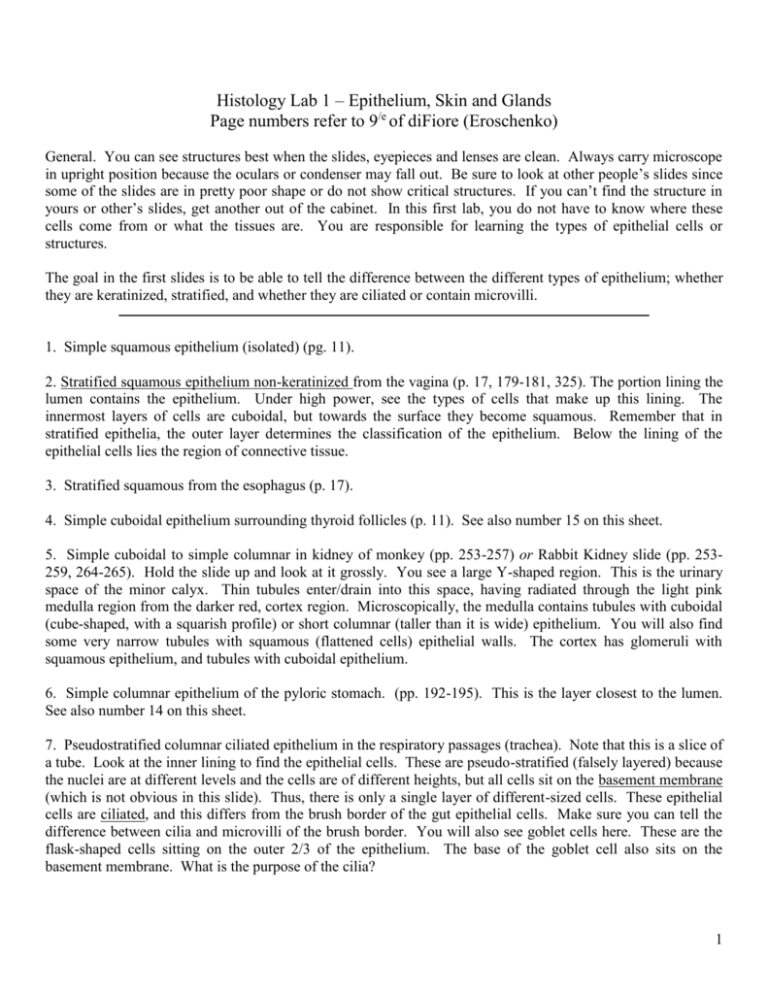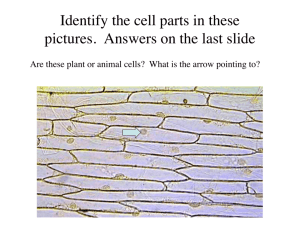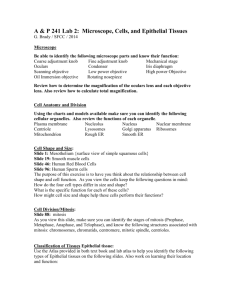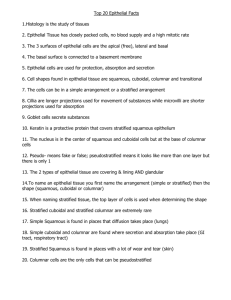Histology Lab 1
advertisement

Histology Lab 1 – Epithelium, Skin and Glands Page numbers refer to 9/e of diFiore (Eroschenko) General. You can see structures best when the slides, eyepieces and lenses are clean. Always carry microscope in upright position because the oculars or condenser may fall out. Be sure to look at other people’s slides since some of the slides are in pretty poor shape or do not show critical structures. If you can’t find the structure in yours or other’s slides, get another out of the cabinet. In this first lab, you do not have to know where these cells come from or what the tissues are. You are responsible for learning the types of epithelial cells or structures. The goal in the first slides is to be able to tell the difference between the different types of epithelium; whether they are keratinized, stratified, and whether they are ciliated or contain microvilli. 1. Simple squamous epithelium (isolated) (pg. 11). 2. Stratified squamous epithelium non-keratinized from the vagina (p. 17, 179-181, 325). The portion lining the lumen contains the epithelium. Under high power, see the types of cells that make up this lining. The innermost layers of cells are cuboidal, but towards the surface they become squamous. Remember that in stratified epithelia, the outer layer determines the classification of the epithelium. Below the lining of the epithelial cells lies the region of connective tissue. 3. Stratified squamous from the esophagus (p. 17). 4. Simple cuboidal epithelium surrounding thyroid follicles (p. 11). See also number 15 on this sheet. 5. Simple cuboidal to simple columnar in kidney of monkey (pp. 253-257) or Rabbit Kidney slide (pp. 253259, 264-265). Hold the slide up and look at it grossly. You see a large Y-shaped region. This is the urinary space of the minor calyx. Thin tubules enter/drain into this space, having radiated through the light pink medulla region from the darker red, cortex region. Microscopically, the medulla contains tubules with cuboidal (cube-shaped, with a squarish profile) or short columnar (taller than it is wide) epithelium. You will also find some very narrow tubules with squamous (flattened cells) epithelial walls. The cortex has glomeruli with squamous epithelium, and tubules with cuboidal epithelium. 6. Simple columnar epithelium of the pyloric stomach. (pp. 192-195). This is the layer closest to the lumen. See also number 14 on this sheet. 7. Pseudostratified columnar ciliated epithelium in the respiratory passages (trachea). Note that this is a slice of a tube. Look at the inner lining to find the epithelial cells. These are pseudo-stratified (falsely layered) because the nuclei are at different levels and the cells are of different heights, but all cells sit on the basement membrane (which is not obvious in this slide). Thus, there is only a single layer of different-sized cells. These epithelial cells are ciliated, and this differs from the brush border of the gut epithelial cells. Make sure you can tell the difference between cilia and microvilli of the brush border. You will also see goblet cells here. These are the flask-shaped cells sitting on the outer 2/3 of the epithelium. The base of the goblet cell also sits on the basement membrane. What is the purpose of the cilia? 1 8. Transitional epithelium of the urinary bladder, (p. 15, 263). The bladder has a folded lumen (central space). This lumen is lined by transitional epithelium. Note the layers of epithelial cells. The outer layer of transitional epithelial cells (sometimes called umbrella cells) has an outer lining of dark red material. This dark lining is formed by the invagination of the membranes to accommodate stretching of the cell when the lumen is expanded (when the bladder fills). 9. Stratified squamous epithelium keratinized (from primate palm) (p. 17). Compare this with the stratified squamous epithelium of the vagina. 10. Mouse tongue or rabbit tongue (p. 157). The upper surface has papillae, which are projections of the stratified squamous epithelium which create friction. The papillae are keratinized. This means that the epithelial cells have died and produced a non-cellular layer of keratin on the surface. Keratinized epithelium lines the body surface for protection. For now note the intact cells under the keratinized layer. In the mouse tounge, note the spiky appearance. These spikes are false intercellular bridges (p. 139 inset). These do not connect the cytoplasm of adjacent cells, but are really sites of cell membrane (junctions, desmosomes) that connect the adjacent epithelial cells. When the material was prepared, there was shrinkage, and the cytoplasm pulled away from the next cell, leaving only the strong desmosomal attachment, creating this appearance. “Stratified squamous” means that the uppermost cells are squamous in appearance, and stratified means there is more than one layer of cells. 11. Mitochondria from turtle liver. This is a special preparation designed to stain mitochondria. Look under high power to see the little dark dots which are the mitochondria. It may be better to look towards the middle of the specimen rather than the periphery. Try not to confuse these with nuclei and nucleoli. 12. Golgi Apparatus. In the electron microscope, this is seen as a system of parallel membranes arranged around the nucleus. On this slide, it is seen as black splotches in the cytoplasm of large round nerve cells (see p. 97). These nerve cells gave a large, light nucleus with a dark dot (nucleolus). 13. Scalp, (p. 143). The skin consists of stratified squamous epithelium, keratinized. The basal layer is cuboidal, but becomes squamous in the upper layers. The cells die and form keratin, which are layers of protein that slough off regularly. Identify the hair follicles, sebaceous (oil) glands, sweat glands and smooth muscles making up the arrector pili muscle. 14. Gut epithelium / Small intestine (duodenum) simple columnar cells (p. 203). First orient yourself under low magnification. The finger-like processes (villi) are cut in different planes, producing different shapes. Under high magnification, observe that the lining of these villi contains a simple columnar epithelium with a striated or brush border (see the electron micrograph). The brush border can be seen as a thin amorphous pink layer at the top of the epithelial cells. In most preparations some cells are different from the simple columnar epithelium. These appear as dark shadows or clear spots on the luminal surface of the epithelium as you focus up and down. These are the goblet cells, which are unicellular mucous secreting cells. Can you tell the active from the inactive cells? Think about euchromatic versus heterochromatic nuclei. 15. Parotid gland (p 169, 175). Identify the secreting portion and the ducts. Most of the gland is make up of serous secreting alveoli (sacs of cells), which have characteristic round, rather light, central nuclei and pink cytoplasm. The ducts look like necklaces, with the cells being cuboidal, stratified cuboidal, to columnar. Examine the large ducts in the spaces between lobules – some of these are stratified cuboidal. 2









